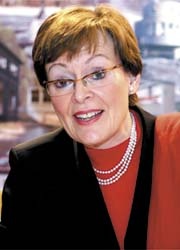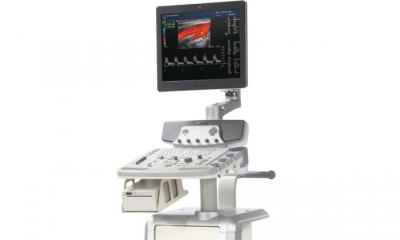Expanding medical horizons
Christian Pruszinsky reports from the ECR 2007
This was the motto of the ECR 2007 in Vienna, where a group of high-ranking experts discussed diseases of the 21st century; research competition between the US and Europe; the conditions needed to progress leading medical R&D - moderated by Congress President Professor Christian
J Herold.

Everyone agreed that increased life expectancy in developed countries will change healthcare demands radically, due to the shift from acute illnesses to chronic disease. Today, 75% of the USA’s healthcare expenditure is on chronic disease treatments, with an upward trend, said Dr Elias Zerhouni, Director of the National Institute of Health (NIH) – annual research budget: 29 billion dollars. He assumes that, in the future, medical and scientific institutions will not ‘only’ have to find solutions for known health problems, but also confront new, often unforeseeable threats, e.g. infectious diseases caused by resistant micro-organisms, pandemics aggravated by worldwide travel, or even biological warfare. The overriding objective must be to take a big step from curative medicine to preventive and personalised medicine, he said, then spoke of a current NIH research initiative, the Pharmacogenetics Research Network, which uses the latest data from genome research, examines interactions between active agents and molecules and studies biological processes through which active agents are removed from the body. Other NIH research projects focus on, for example, Alzheimer’s disease; integrated sensors and lab-on-chip for lab tests; imaging osteoarthritis; autism; technologies for nerve regeneration; imaging for cancer research and care; influenza drug screening, and AIDS structural biology.
Decisive factors in medical research are the development and implementation of innovative findings from genome research, the development of suitable biomarkers, embryonic stem cell research, pharmacogenetics, cell biology, nanobiotechnology, robotics technology as well as new imaging procedures. Global competition for the best scientists in the medical disciplines is correspondingly hot. Countries increasingly compete to attract the most talented and imaginative students in medical research to their own universities.
Professor Liselotte Hojgaard, Chair of the Committee for the European Medical Research Council (EMRC) and Head of the Department of Clinical Physiology and Nuclear Medicine, PET and Cyclotron Unit at Copenhagen University Hospital, explained that Europe has a lot of catching up to do in this area: ‘The relative share of public research money allocated to medicine and the life sciences is 55% and only about 30% in Europe. In the US they spend 2.6% of GDP on research, in the EU only 1.93 – and US GDP is 30% higher than European GDP.’ Add to that the diversity of all the systems: Whereas the US has a large, standardised budget for funding, a common strategy and objective, co-ordinated approach and just a few, highly specialised, private universities, in Europe 90% of funding for R&D comes from national research institutions and 7–8% from the EU budget.
The EC Framework Programme 7, which anticipates spending in the region of 50 billion Euros on R&D from 2007 to 2013, represents an important step forward. ?12 billion of this will go towards the new European Research Council (ERC) – the first cross-national agency to promote forward-thinking research work. The Barcelona objective to increase the proportion of the GDP spent on research in EU member states to 3% by 2010 should increase the budget further. However, the fact that each country has its own specific objectives, strategies, priorities and traditions, and there is still disagreement over how research funds should be spent, remains problematic.
Interdisciplinary co-operation and cross-national projects, including universities and research institutions, are becoming benchmarks for the efficiency of European research policies: ‘The European Institute for Biomedical Imaging Research (EIBIR) has a mission to create an environment and infrastructure that strengthens biomedical imaging research in Europe. This initiative is warmly welcomed and supported by EMRC,’ said Professor Hojgaard. The European Strategic Forum of Research Infrastructure (ESFRI) is developing proposals on large research infrastructures in biobanks, translational research and clinical trial centres and at the moment on the roadmap for European Research.
Global market place of ideas
Attracting the best talent produces the best research results, if those scientists receive the best working conditions and training, and the highest level of creative freedom – essential to nurture innovative ideas.
William R Brody, President of John Hopkins University, Baltimore (annual budget 1.5 billion dollars) sees advantages for the USA in the ever-rising global competition to attract talented scientists. The allocation of research subsidies is based on peer-review-systems. So universities that can recruit the most talent can count on significant research funding. Little political pressure, a flat, organisational structure and a calculable, basic financial configuration ensure good working conditions for universities and research teams which, unlike in Europe, are not dominated hierarchically. This appeal ensures that US universities fare very well in global recruitment of talent. In the technical disciplines and computer sciences almost 50% of PhD students are from abroad, every third university lecturer at these universities also comes from abroad.
However, Brody sees great challenges in the competition for the most talented medical researchers in the US:
- Decreasing funding endangers important investments – for a few years, subsidies for fundamental research have not been adjusted to account for inflation
- Stricter immigration laws, implemented following 9/11, have complicated foreign student recruitment
- Other countries’ efforts to attract new, international academic talent has led to noticeable headhunting
-l Research-oriented universities are under significant financial pressure due to the cap on state funding.
He sees a fundamental change in scientific culture because of the development of interdisciplinary structures: ‘…to work on, for example, degenerative neurological diseases, may require biologists, neurologists, geneticists, radiologists, computer scientists and biomedical engineers to work together.’ Data-sharing is a key word for the future.
To promote this increasing interdisciplinary co-operation John Hopkins University has established a number of new centres, e.g. the Institute for Nanobiotechnology; Institute for Computational Medicine, and the Brain Science Institute, where neuroscientists and other brain researchers can work with geneticists, technicians and experts for imaging procedures.
Professor Wolfgang Schuetz, Vice Chancellor of the Medical University of Vienna (MUW) and Prof Christian Herold spoke of changes to academic research in Austria. The trend towards a peer-review system to rate projects leads to higher quality standards, performance-oriented research funding through an increase in income from third-party funds (+50% over three years), the advancement of internationalisation through new partnerships, e.g. with Yale School of Medicine and Stanford University, but particularly the development of not exclusively clinic-oriented fundamental research in strategically important and trend-setting research areas, are all distinct markers of change. Not without pride did Herold report about the Centre of Excellence for High-Field MR at the Medical University of Vienna. Set up as a co-operation between the Clinic of Radiodiagnostics and the Centre for Biomedical Technology and Physics, already it is ranked among leading international centres of this kind.
01.05.2007











